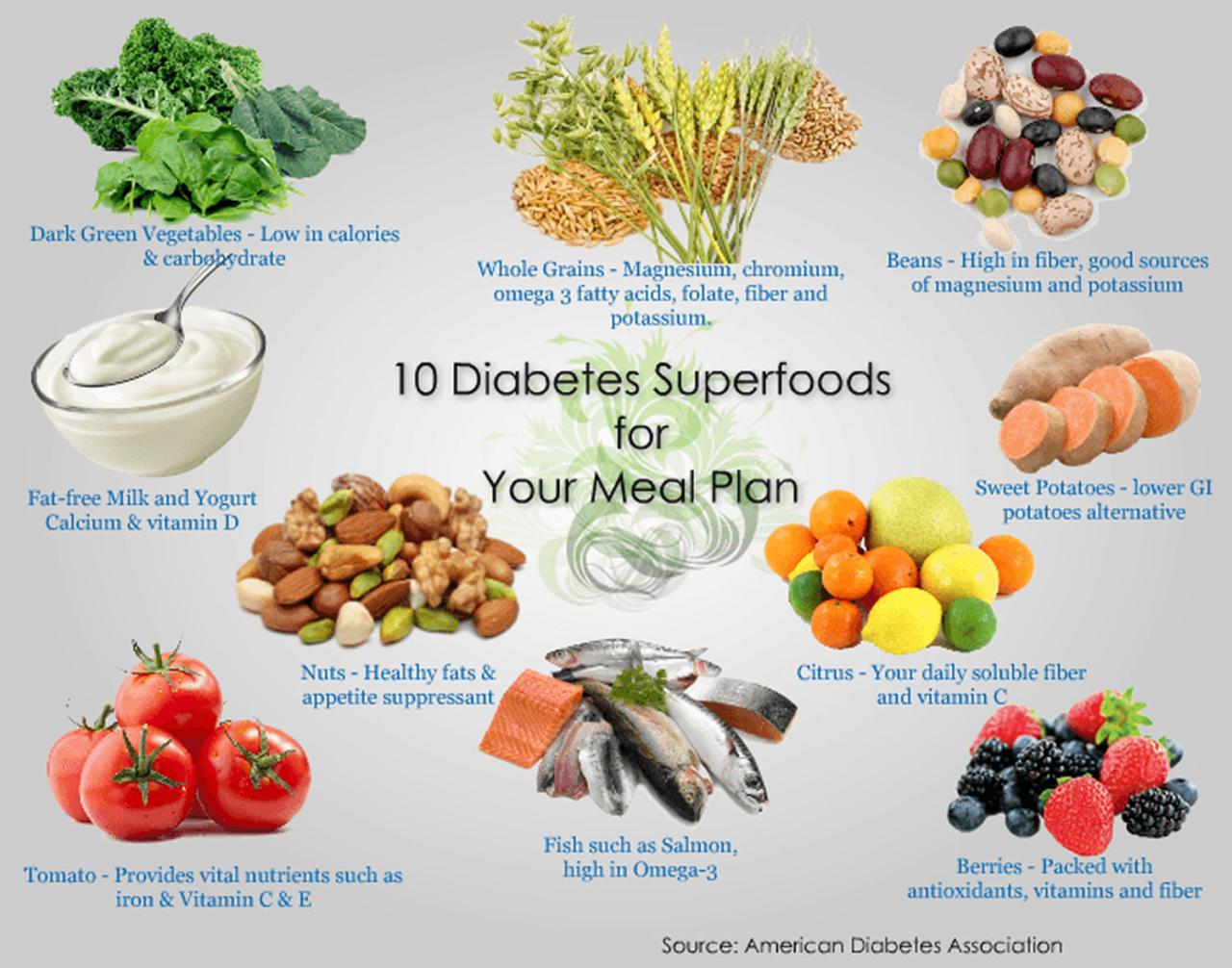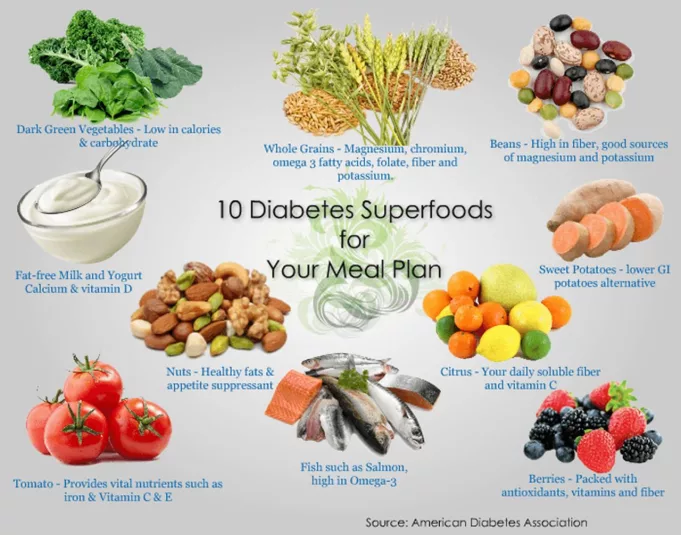Best Diet for Diabetics: Navigating the world of diabetes can feel like a sugar-coated maze, but understanding the right diet can be your compass to better health. This guide will demystify the complexities of diabetes management and equip you with the knowledge to create a delicious and effective meal plan.
Diabetes is a chronic condition that affects how your body regulates blood sugar. It’s a condition that requires careful management, and a well-balanced diet plays a crucial role in keeping your blood sugar levels in check. This guide will delve into the fundamentals of diabetes management, exploring the essential dietary principles, food choices, and meal planning strategies to help you thrive with diabetes.
Understanding Diabetes
Diabetes is a chronic condition that affects how your body regulates blood sugar, also known as glucose. It’s a serious health concern that can lead to various complications if left untreated. But don’t worry, with proper management and lifestyle changes, you can live a healthy and fulfilling life.
Types of Diabetes
Diabetes comes in different flavors, each with its own unique characteristics. Let’s break down the different types:
- Type 1 Diabetes:This type is an autoimmune disease where your body mistakenly attacks and destroys the insulin-producing cells in your pancreas. This leaves you unable to produce insulin, a hormone crucial for regulating blood sugar. It usually develops in childhood or adolescence, but can also appear later in life.Think of it as your immune system getting a bit too enthusiastic and attacking the wrong cells.
- Type 2 Diabetes:This type is more common and often develops in adulthood. It’s characterized by insulin resistance, meaning your body doesn’t use insulin effectively. This can lead to high blood sugar levels. It’s like your body is throwing a party, but the guests (insulin) can’t get into the house (cells) to enjoy the food (glucose).
- Gestational Diabetes:This type develops during pregnancy and usually disappears after childbirth. It’s caused by hormonal changes that make it harder for your body to use insulin effectively. It’s like a temporary guest crashing the party and disrupting the flow of things.
Complications of Uncontrolled Diabetes
Diabetes can be a real party pooper if left unchecked. Here are some of the complications that can arise:
- Heart Disease:High blood sugar can damage blood vessels, increasing the risk of heart attacks and strokes. It’s like your blood vessels are getting clogged up with too much sugar, hindering the flow of blood.
- Kidney Disease:High blood sugar can damage the tiny blood vessels in your kidneys, leading to kidney failure. It’s like your kidneys are trying to filter out too much sugar, straining their system.
- Nerve Damage:High blood sugar can damage nerves, causing numbness, tingling, and pain, particularly in the hands and feet. It’s like your nerves are getting overloaded with sugar, leading to communication problems.
- Eye Damage:High blood sugar can damage the blood vessels in your eyes, increasing the risk of blindness. It’s like your eyes are getting a sugar rush, leading to blurred vision.
- Foot Problems:High blood sugar can lead to poor circulation and nerve damage in your feet, making them more susceptible to infections and ulcers. It’s like your feet are getting a sugar coma, making them less responsive and more prone to injuries.
Importance of Blood Sugar Management
Managing blood sugar is crucial for preventing and managing diabetes complications. It’s like keeping your blood sugar levels in check is like maintaining a healthy balance in your body’s sugar party. Here’s how you can do it:
“Regular blood sugar monitoring, a healthy diet, regular exercise, and medication if needed are all essential for effective blood sugar management.”
Finding the best diet for diabetics can be a real head-scratcher, but remember, it’s all about managing those blood sugar levels. Some folks swear by the keto diet , which emphasizes fat and protein, and limits carbs. While it might sound like a dream for some, it’s important to consult with your doctor before making any major dietary changes, especially if you’re living with diabetes.
Dietary Principles for Diabetes
Managing diabetes involves a lot more than just taking medication; it’s about adopting a lifestyle that supports healthy blood sugar levels. A well-planned diet is a crucial part of this lifestyle, and it’s not about deprivation but rather about making informed choices.
Carbohydrates in a Diabetic Diet
Carbohydrates are the primary source of energy for our bodies, but they also have a significant impact on blood sugar levels. For individuals with diabetes, understanding how different types of carbohydrates affect blood sugar is essential.
- Simple carbohydratesare quickly absorbed into the bloodstream, causing a rapid spike in blood sugar levels. Examples include sugary drinks, candy, white bread, and refined grains. Limiting these foods is essential for diabetes management.
- Complex carbohydratesare broken down more slowly, resulting in a gradual increase in blood sugar levels. Examples include whole grains, legumes, and starchy vegetables. These are preferred choices for people with diabetes.
Protein and Fats in Diabetes Management
Protein and fats play crucial roles in a diabetic diet, helping to regulate blood sugar and provide essential nutrients.
So you’re looking for the best diet for diabetes? It’s all about finding the right balance, like a tightrope walker navigating a sugar-coated canyon. But before you start juggling carbs and proteins, it’s a good idea to brush up on your nutrition facts to make sure you’re not accidentally juggling grenades.
With a little knowledge and a good dose of willpower, you can walk that tightrope and keep your blood sugar in check.
- Proteinhelps to stabilize blood sugar levels by slowing down the absorption of carbohydrates. It also helps in building and repairing tissues, making it an essential nutrient for overall health.
- Fatsare important for energy production and hormone regulation. However, it’s crucial to choose healthy fats, such as those found in olive oil, avocados, nuts, and fatty fish. These fats can help improve insulin sensitivity and lower bad cholesterol levels.
Fiber: The Blood Sugar Superhero
Fiber is a type of carbohydrate that our bodies cannot digest. It plays a vital role in blood sugar control by slowing down the absorption of sugar and adding bulk to the stool.
- Soluble fiberdissolves in water and forms a gel-like substance in the digestive tract. This gel slows down the absorption of sugar, helping to regulate blood sugar levels. Examples include oats, beans, lentils, and apples.
- Insoluble fiberdoes not dissolve in water and adds bulk to the stool, promoting regular bowel movements. Examples include wheat bran, whole grains, and vegetables like broccoli and carrots.
Including fiber-rich foods in your diet can significantly improve blood sugar control and overall health.
Food Choices for Diabetics
Navigating the world of food as a diabetic can feel like a minefield, but it doesn’t have to be a constant struggle. Understanding how different foods affect your blood sugar is key to making informed choices that support your health.
Glycemic Index and Food Choices
The glycemic index (GI) measures how quickly a food raises your blood sugar level. Foods with a high GI are rapidly digested and cause a spike in blood sugar, while low-GI foods are digested slowly and cause a gradual rise in blood sugar.
| Food Category | Glycemic Index (GI) |
|---|---|
| High GI (70 or above) | White bread, potatoes, sugary drinks, white rice |
| Medium GI (56-69) | Brown rice, corn, sweet potatoes, pineapple |
| Low GI (55 or below) | Whole grains, legumes, most fruits, non-starchy vegetables |
Low-GI Food Choices for Diabetics
Choosing low-GI foods is a smart strategy for managing blood sugar levels. Here are some examples of low-GI foods you can incorporate into your diet:
- Whole Grains:Whole wheat bread, brown rice, quinoa, oats, barley
- Legumes:Lentils, beans, chickpeas, peas
- Fruits:Apples, pears, berries, oranges, grapefruit
- Non-Starchy Vegetables:Broccoli, spinach, kale, carrots, celery, peppers
- Nuts and Seeds:Almonds, walnuts, chia seeds, flax seeds
Benefits of Lean Protein, Healthy Fats, and Non-Starchy Vegetables
Incorporating these food groups into your diet can have significant benefits for blood sugar control and overall health.
- Lean Protein:Lean protein sources like chicken breast, fish, tofu, and beans help stabilize blood sugar levels by slowing down digestion. Protein also helps maintain muscle mass, which is important for people with diabetes.
- Healthy Fats:Healthy fats found in olive oil, avocados, nuts, and seeds can improve insulin sensitivity, which means your body uses insulin more effectively to regulate blood sugar.
- Non-Starchy Vegetables:Non-starchy vegetables are low in calories and carbohydrates, making them an excellent choice for managing blood sugar. They are also packed with vitamins, minerals, and fiber, which contribute to overall health.
Meal Planning Strategies
Meal planning is a crucial aspect of managing diabetes. By strategically planning your meals and snacks, you can effectively control your blood sugar levels, prevent fluctuations, and achieve your overall health goals.
Sample Meal Plan for Diabetics, Best diet for diabetics
This sample meal plan provides a balanced and nutritious approach to managing diabetes, incorporating a variety of food groups and portion sizes.
Breakfast
- 1 cup oatmeal with 1/4 cup berries and 1/2 cup skim milk
- 2 eggs with 1 slice whole-wheat toast and 1/4 cup avocado
- 1 cup Greek yogurt with 1/4 cup granola and 1/2 cup fruit
Lunch
- Salad with 4 oz grilled chicken or fish, 1 cup mixed greens, 1/2 cup vegetables, and 2 tablespoons vinaigrette dressing
- Whole-wheat sandwich with 2 oz lean turkey or ham, 1/4 cup vegetables, and 1 tablespoon mustard
- 1 cup lentil soup with 1 slice whole-wheat bread
Dinner
- 4 oz baked salmon with 1/2 cup steamed vegetables and 1/2 cup brown rice
- 1 cup vegetarian chili with 1 slice whole-wheat bread
- 4 oz chicken stir-fry with 1 cup vegetables and 1/2 cup brown rice
Portion Control and Mindful Eating
Portion control and mindful eating are essential for maintaining stable blood sugar levels.* Portion control:Use smaller plates and bowls to help regulate portion sizes.
Mindful eating
Pay attention to your hunger and fullness cues. Eat slowly and savor each bite.
Read food labels
Carefully review serving sizes and nutritional information to make informed choices.
Regular Meal Timing and Snacking
Regular meal timing and snacking can help prevent blood sugar spikes and crashes.* Eat meals at consistent times:This helps regulate insulin production and maintain stable blood sugar levels.
Snack between meals
Healthy snacks can prevent blood sugar drops and keep you feeling energized.
Avoid skipping meals
Skipping meals can lead to significant blood sugar fluctuations.
Healthy Eating Habits
Adopting healthy eating habits is crucial for managing diabetes. It’s not about deprivation but about making smart choices that keep your blood sugar levels stable and prevent complications.
Practical Tips for Healthy Eating
These practical tips can help you incorporate healthy eating habits into your daily routine:
- Start your day with a nutritious breakfast:A balanced breakfast, such as oatmeal with berries and nuts, helps stabilize blood sugar levels throughout the morning. It’s like giving your body a gentle nudge to get going!
- Choose whole grains over refined grains:Whole grains, like brown rice and whole-wheat bread, are packed with fiber, which slows down the absorption of sugar into your bloodstream. Think of them as tiny superheroes fighting off blood sugar spikes!
- Incorporate lean protein sources:Lean proteins, such as fish, poultry, beans, and tofu, help keep you feeling full and satisfied, reducing the urge to overeat. They’re like the anchor of your meals, keeping everything balanced.
- Limit saturated and trans fats:These unhealthy fats can raise cholesterol levels and increase the risk of heart disease. Think of them as the villains of your diet, so it’s best to keep them at bay.
- Choose healthy fats:Unsaturated fats, found in avocados, nuts, and olive oil, are good for your heart and can help manage blood sugar levels. They’re the good guys of the fat world!
- Hydrate with water:Water helps regulate blood sugar levels and keeps you feeling full. It’s the unsung hero of your diet, working behind the scenes to keep things running smoothly.
- Read food labels carefully:Pay attention to serving sizes, calories, and the amount of sugar, fat, and sodium in packaged foods. This is like being a detective, uncovering the hidden details of your food choices.
- Plan your meals and snacks:Having a plan in place can help you make healthier choices and avoid impulsive decisions. It’s like having a roadmap for your food journey!
Strategies for Avoiding Unhealthy Foods
Here are some tips for avoiding processed foods, sugary drinks, and unhealthy fats:
- Cook more meals at home:This gives you control over the ingredients and helps you avoid hidden sugars and unhealthy fats. It’s like being the chef of your own healthy destiny!
- Limit processed foods:Processed foods are often high in sugar, unhealthy fats, and sodium. Think of them as the “fast food” of the food world, tempting but not always good for you.
- Say no to sugary drinks:Sugary drinks, like soda and fruit juice, can quickly spike blood sugar levels. Think of them as the sugar bombs of your diet, so it’s best to avoid them.
- Choose healthy snacks:Keep healthy snacks, like fruits, vegetables, and nuts, on hand to avoid reaching for unhealthy options. These are like the secret weapons of your diet, helping you stay on track.
- Read labels carefully:Many packaged foods contain hidden sugars and unhealthy fats. It’s like being a detective, uncovering the hidden details of your food choices.
The Importance of Physical Activity
Regular physical activity plays a vital role in blood sugar control. It helps your body use glucose more efficiently, improving insulin sensitivity. Think of it as a workout for your blood sugar levels, making them more responsive and manageable.
“Exercise is like medicine. It’s a great way to help control your blood sugar levels and improve your overall health.”
The Role of Hydration

Staying hydrated is crucial for everyone, but it’s especially important for people with diabetes. Water plays a vital role in regulating blood sugar levels, preventing dehydration, and supporting overall health.
Water Intake Recommendations for Diabetics
The amount of water you need daily depends on several factors, including your activity level, climate, and overall health. However, a general guideline for adults is to drink about eight glasses of water per day. For individuals with diabetes, staying hydrated is particularly essential.
Here are some recommendations:
- Aim for at least eight glasses of water per day, and more if you’re physically active or live in a hot climate.
- Consider carrying a reusable water bottle with you throughout the day to remind yourself to drink.
- Drink water before, during, and after exercise to replenish fluids lost through sweat.
- Consult your doctor or a registered dietitian for personalized recommendations based on your individual needs.
Benefits of Water Consumption for Blood Sugar Management
Drinking enough water can help manage blood sugar levels in several ways:
- Helps regulate insulin sensitivity:Water can help improve your body’s response to insulin, which is crucial for regulating blood sugar.
- Prevents dehydration:Dehydration can lead to increased blood sugar levels. Staying hydrated helps prevent this fluctuation.
- Promotes kidney function:Water is essential for proper kidney function, which plays a role in filtering waste products from the blood, including excess glucose.
- Reduces the risk of complications:Staying hydrated can help prevent complications associated with diabetes, such as nerve damage and kidney disease.
Consulting a Healthcare Professional: Best Diet For Diabetics
Navigating the world of diabetes can feel overwhelming, and that’s where professional guidance comes in. A qualified healthcare professional can help you tailor a diabetes management plan that fits your unique needs and lifestyle.
So you’re looking for the best diet for diabetics? You’re not alone! It’s a balancing act between keeping your blood sugar stable and enjoying delicious food. And while a healthy diet is key, it’s not always about restrictions.
Sometimes, a little weight loss can make a big difference, too! Check out this article on the best diet to lose weight for some helpful tips. Remember, finding the right balance is the secret to feeling your best, both physically and mentally.
So, get out there, explore your options, and don’t be afraid to experiment! You might be surprised by how much you enjoy the journey.
Importance of Professional Guidance
Seeking advice from a registered dietitian or endocrinologist is crucial for effective diabetes management. These professionals possess the expertise to create personalized dietary plans, address specific concerns, and monitor your progress.
Finding a Qualified Healthcare Professional
- Ask your primary care physician for recommendations.Your doctor likely has experience with diabetes management and can suggest qualified professionals in your area.
- Consult with your insurance provider.Your insurance plan may have a network of registered dietitians or endocrinologists, which can save you money on consultations.
- Look for certified professionals.The Academy of Nutrition and Dietetics (AND) and the American Diabetes Association (ADA) offer certifications for registered dietitians and endocrinologists specializing in diabetes care.
The Role of Regular Monitoring and Adjustments
Once you’ve established a diabetes management plan, regular monitoring is essential. Your healthcare professional will work with you to:
- Track your blood sugar levels.This allows you to see how your diet and lifestyle choices affect your blood sugar control.
- Review your progress.Regular check-ups help ensure your diabetes management plan remains effective and adjust it as needed.
- Address any concerns or side effects.You can discuss any challenges you’re facing with your diet, medications, or other aspects of your diabetes management.
Tips for Effective Communication
- Keep a food diary.This helps you track your food intake and identify patterns that may be affecting your blood sugar levels.
- Be open and honest with your healthcare provider.Share any concerns or challenges you’re facing with your diabetes management.
- Ask questions.Don’t hesitate to clarify any information or express any doubts you may have.
Last Point
By adopting a diabetes-friendly diet, you’re not just managing a condition, you’re actively taking control of your health and well-being. Remember, consistency is key! It’s a journey, not a sprint, and small changes over time can lead to significant improvements in your overall health.
Embrace the power of food and embark on a path to a healthier, happier you.
Questions Often Asked
Can I still enjoy my favorite foods with diabetes?
Absolutely! While you may need to adjust portion sizes and make healthier swaps, you can still enjoy your favorite foods in moderation. The key is to focus on creating a balanced diet that includes a variety of nutritious foods.
What are some common diabetes-friendly snacks?
Some great snack options include a handful of nuts, a piece of fruit with a tablespoon of peanut butter, a hard-boiled egg, or a small bowl of yogurt with berries. These snacks provide a balance of protein, healthy fats, and fiber, helping to stabilize blood sugar levels.
Does exercise really help with diabetes?
Yes, exercise is a powerful tool for managing diabetes. It helps your body use insulin more effectively, leading to better blood sugar control. Aim for at least 30 minutes of moderate-intensity exercise most days of the week.
























